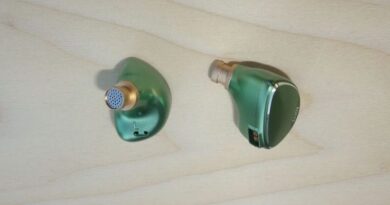Using Headphones With Your New Mac [Without An External DAC/Amp] – A Review
The latest Mac generation features a relatively good audio circuit that makes many budget dongles and headphone amps obsolete.
Introduction
Apple computers, unlike the company’s mobile devices, have traditionally delivered poor audio quality through their 3.5 mm headphone socket. And most Windows machines are not any better.
Plugging an earphone or headphone into my 2012 MacBook Air and listening to iTunes/Apple Music creates a dull and blunt listening experience. This low quality is a contradiction to the capabilities of digital audio, which goes back at least 20 years. Even the 2013 iPhone 5S had stunning audio quality. Similarly, Apple’s “Lightning to 3.5 mm Audio Adapter” delivers excellent sound quality.
In order to make computers sound better, digital audio pioneer Gordon Rankin of Wavelength Audio (and contractor to AudioQuest), invented the dongle DAC back in 2012, the DragonFly Black. A tiny device without its own battery, it drew power from the host. The DragonFly was restricted to use with a computer as it drew more than 100 mA, too much for iPhone to handle.
As of 2016, the next version of the “Black” was within the iPhone’s current draw tolerance. Many companies jumped on the bandwagon flooding the market with such devices. But not all dongles are equal and ALL of them are a compromise. Such that draw little current (and therefore drain your phone company slowly) have limited power, and the powerful ones empty your phone’s battery fast.
When it comes to dongle-DAC use with computers, current drain is largely irrelevant considering that desktop machines don’t have a battery at all, and notebooks have high battery capacities compared to a phone. Power is therefore no problem with computer application, sound quality has foremost priority.
Dongle DACs typically have 1 to 2 V, depending on impedance. Some, such as the Helm Bolt, automatically switch voltage depending on detected headphone impedance.
Apple introduced a new integrated audio circuit in their latest models:
- MacBook Air introduced in 2022
- MacBook Pro introduced in 2021 or later
- Mac mini introduced in 2023
- Mac Studio introduced in 2022
These models contain an audio circuit that is power wise very similar to dongles such as the Helm Bolt, ifi Audio GO Link, DragonFly Red and Cobalt. Below 150 ohm headphone impedance, the circuit provides a voltage of 1.25 V RMS, above 150 ohm and up to 1000 ohm, the headphone jack delivers 3 V RMS. You find Apple’s respective support article here.
Apple’s integrated DAC supports sample rates up to 96 kHz (just like the AudioQuest DragonFly Cobalt).
I calculated the resulting power and current drain as displayed in the following table:
| Impedance [ohm] | Power [mW] | Voltage [V] | Current [mA] |
|---|---|---|---|
| 32 | 48.8 | 1.25 | 39.1 |
| 70 | 22.3 | 1.25 | 17.9 |
| 150 | 10.4 | 1.25 | 8.3 |
| 300 | 30.0 | 3 | 10.0 |
| 600 | 15.0 | 3 | 5.0 |
| 1000 | 9.0 | 3 | 3.0 |
What we have learnt so far is that Apple’s new audio circuit is as powerful as a standard dongle DAC of the kind that also works with a phone. Yes, there are more powerful dongles on the market such as the Apogee Groove, Questyle M15, or ifi Audio Go bar, which will work better with insensitive headphones.
![Using Headphones With Your New Mac [Without An External DAC/Amp] - A Review 2 mac](https://www.audioreviews.org/wp-content/uploads/2023/05/mac2.jpg)
The 2022 MacBook Air with the M2 processor has its headphone jack on the right-hand side.
Amplification and Sound Quality
Playing in-ears with 32 ohm impedance is a piece of cake, even the 70 ohm Sennheiser HD 25 headphones (on the title photo) get lots of volume. Just like many “standard dongle DACs”, the 300 ohm Sennheiser HD 600 brings the Mac audio to its limits. Yes, it principally works, but it lacks pizazz.
The current-hungry Final E5000 iems are a special case in that they do not run well with most current-conserving dongle DACs and daps, for example the ifi Go link, Helm Bolt or TempoTec V6. They play loud enough but lack bass control, an indication that hey don’t receive enough current.
My testing confirms the tech data comparison with comparable dongles.
And here comes the surprise: the sound quality of Apple’s new audio quality is…astonishingly good for what it is: crisp, transparent, clear. Very surprising. It sounds very similar (in terms of quality) to the ifi Go link or Helm Bolt.
Concluding Remarks
Apple’s new adaptive audio circuit finally sounds quite decent. Poor audio circuits in computers were the reason for the invention of the dongle DAC. The idea was to keep it small, down to the size of a thumb drive.
Some basic $50-100 dongle DACs have now become obsolete for modern Macs, which makes these devices even more compact. Where Apple are exaggerating is with the compatibility with high-impedance headphones. It principally works, but you are better off with a dedicated, powerful, headphone DAC/amp such as the ifi GO bar or the Questyle M15 on the go.
Testing this is easy: if you have a new Mac, try it out. If you don’t have one, don’t bother as you won’t buy one for this purpose anyway.
Until next time…keep on listening!
![Using Headphones With Your New Mac [Without An External DAC/Amp] - A Review 3 Jürgen Kraus signature](https://www.audioreviews.org/wp-content/uploads/2020/02/Document1.jpg)
Disclaimer
Our generic standard disclaimer.
![Using Headphones With Your New Mac [Without An External DAC/Amp] - A Review 4 FB Group](https://www.audioreviews.org/wp-content/uploads/2020/01/FB-group.jpg)
![Using Headphones With Your New Mac [Without An External DAC/Amp] - A Review 5 youtube](https://www.audioreviews.org/wp-content/uploads/2020/05/youtube.jpeg)

![Using Headphones With Your New Mac [Without An External DAC/Amp] - A Review 1 Headphones Mac](https://www.audioreviews.org/wp-content/uploads/2023/05/Headphones-Mac.jpg)
![Using Headphones With Your New Mac [Without An External DAC/Amp] - A Review 6 Jürgen Kraus (Calgary, Canada)](https://www.audioreviews.org/wp-content/uploads/2021/09/jk-greeen.jpg)


